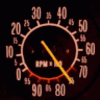I have used epoxy to fill manifolds now for 20 years and have not had one fail ! Rough surface up really well for good adhesion and clean with acetone , has always worked well !! Good luck Duggan

AIR SPEED
#51

Posted 13 March 2015 - 08:08 AM
#52

Posted 13 March 2015 - 10:30 AM
From another point of view , the exhaust valve "sees" a flat "face" on it's way out , even though it has some pressure up it's arse they reckon an exhaust valve is more efficient than an intake valve , hence they are smaller.
Exhaust valve is smaller because the exhausting charge is smaller in relation to the intake charge.
If you want to know what is the latest and greatest in valve and porting then look at small capacity motorcycle heads of the last 50yrs.
#53
 _oldjohnno_
_oldjohnno_
Posted 13 March 2015 - 02:29 PM
Exhaust valve is smaller because the exhausting charge is smaller in relation to the intake charge.
Huh?
#54

Posted 13 March 2015 - 05:06 PM
14.7 psi in ?, and old figure of 400psi at fire up ,and still some left in cylinder when exhaust opens,round about 2800 pounds on top
of 3inch diameter piston ? , must be a some pressure left in there after all that ?
#55

Posted 13 March 2015 - 09:18 PM
Don,t know if the file I have attached is any help, can't remember who gave it to me but I am assured it is a very usefull, well researched tool. If I recall correctly one of the worlds leading head/ flow bench gurus may have had something to do with it. David Vizard perhaps?
Attached Files
Edited by caterham2, 13 March 2015 - 09:18 PM.
#56
 _Bomber Watson_
_Bomber Watson_
Posted 13 March 2015 - 09:44 PM
14.7 psi in ?, and old figure of 400psi at fire up ,and still some left in cylinder when exhaust opens,round about 2800 pounds on top
of 3inch diameter piston ? , must be a some pressure left in there after all that ?
Generally when a gas is heated it expands, and obviously when that happens in a closed environment pressure develops...Got me #@$^%& how it could be smaller as Terry suggests?
#57
 _duggan208_
_duggan208_
Posted 13 March 2015 - 10:48 PM
Thanks guys, but I'll look at these posts a bit later, I lost my little mate of 15 years today, its strange that a 4 kg tan and white dog can leave such a fr0cking great hole, feel like shit.
regards
#58
 _Bomber Watson_
_Bomber Watson_
Posted 13 March 2015 - 11:01 PM
Absolutely understandable.
My greatest condolences. They mean so much.
#59
 _oldjohnno_
_oldjohnno_
Posted 14 March 2015 - 06:41 AM
Sorry to hear that Jon, I know exactly how you're feeling.
#60
 _oldjohnno_
_oldjohnno_
Posted 14 March 2015 - 08:30 AM
Don,t know if the file I have attached is any help, can't remember who gave it to me but I am assured it is a very usefull, well researched tool. If I recall correctly one of the worlds leading head/ flow bench gurus may have had something to do with it. David Vizard perhaps?
It's interesting that many of the "performance" gurus spout things like valve sizing formulas as if they'd come up with them themselves. In fact most of them have been lifted directly from John Heywoods book from nearly 30 years ago, Internal Combustion Engines Fundamentals. I think this book has as much good information in it as all the "performance" publications combined, and if you're going to have only one book in your engine library this - or Taylors - should be it.
The spreadsheet is interesting but fundamentally flawed in that it implies that valve area is of significance which is very misleading. Unfortunately there is no direct link between cylinder size and valve sizing, but despite this countless engines are built using rules-of-thumb like the "52%" rule that can really only work over a limited range of cylinder sizes.
If this isn't immediately apparent think about this: a cylinders size (and therefore air demand) is in proportion to the square of its diameter. Double the bore size and the capacity (and flow requirement) goes up by a factor of four. Valve flow capacity works differently though - it only cares about curtain area, ie. circumference x lift. In other words it is the diameter, not the area, that is important. Doubling the diameter only gives double the flow, not four times as much.
Once you get your head around this lots of things suddenly make sense. For example the need for more and more cam duration as the cylinder size increases to maintain the same rpm range. Or why you can make more rpms and power with lots of small cylinders than you can with a few big ones, despite the cost in heat losses and friction. Or why some small motorcycle engines were able to make good power despite head designs that would be totally inadequate on a big-block. At any rate the bottom line is this: you do whatever you have to do to achieve the required flow rate - or get as close to it as you can - and do the rest with the camshaft.
Edited by oldjohnno, 14 March 2015 - 08:32 AM.
#61

Posted 14 March 2015 - 10:39 AM
Generally when a gas is heated it expands, and obviously when that happens in a closed environment pressure develops...Got me #@$^%& how it could be smaller as Terry suggests?
The fact that it's under pressure means it flows through a given size opening
quicker anyway. The very reason it can be smaller than the intake valve.
You will also find that due to design/performance requirements that the inlet valve is larger.
Also, where I was leading into is that the Intake charge is dense, laden with cool fuel, needing quite a large area to flow thru into a vacuum, the exhaust is quite dry in comparison (even with h2o present as a by product) and altho expanding and pushing it's way out as it expels from the combustion it is quite dry by comparison by way of the chemical conversion as a result of combustion.
You will never get more exhaust over intake charge as alot of the energy is used up pushing the piston, in other words it's all burnt up.
I think of it like a drum full of wood, the opening in the top has to be quite large to fit big pieces of wood into it but the opening at the bottom to remove the ash is relatively small in comparison as all the energy has been turned into heat and has reduced the wood to ash.
The burning wood radiates energy into it's surrounds and whats left after the fire is the waste.
#62
 _oldjohnno_
_oldjohnno_
Posted 14 March 2015 - 11:15 AM
The fact that it's under pressure means it flows through a given size opening
quicker anyway...
I agree with this bit but not the rest.
Sure, when you burn wood in a fire bucket the ash left over has much less mass than the original fuel. But you're ignoring all the CO, CO2 and so on that was released during combustion. If you burn fuel in a closed container and measure the mass before and after combustion (some of you may have done this in high school physics) there is no loss of mass.
Bombers right (of course!), Charles Law says the volume of a set mass of gas is in direct proportion to its pressure and temperature. And because the exhaust gas is still quite hot it has quite a bit more volume than when it was cool on the way in. You can see proof of this with a turbocharger - they are able to produce boost without the hot side running at a much higher pressure than the cold side purely because of the hotter (and therefore "bulkier") gas running through the turbine.
There's a hell of a lot going on during the exhaust cycle, interesting stuff that isn't always what you'd expect.
#63

Posted 14 March 2015 - 05:17 PM
They reckon that a critical flow condition will apply when mass flow is the maximum possible for the existing upstream conditions,this is supposed to occur when velocity reaches Mach1 through a restriction?,this restriction could be the valve throat or the manifold or the "choke" on carb. ?
There must be some "simplish" way to work this out just using numbers,given that at sea level we have a certain pressure,and usually
from knowing at least 2 things an answer can be derived,even if one or two of those things involve using a calculator?
just thinkin,,,thats all!
Easy to see how a cold fuel laden mix causes pressure,,
1. 44 gallon drum
2. add required petrol to air weight/volume to suit drum
3.leave small bung out of drum
4.grab a 4 foot long stick and wrap a piece of rag around one end and make a wick
5.stand back and place lit wick in the area of small bung
6.almost forgot,, make sure the seam of the drum is facing away during experiment
dont try that at home...the Mrs will want new windows or something ![]()
p.s. even an old 23 Model T will start sometimes just by turning the ignition on after it has been just shut off...depends where things landed with a cylinder full.
#64
 _oldjohnno_
_oldjohnno_
Posted 14 March 2015 - 05:58 PM
They reckon that a critical flow condition will apply when mass flow is the maximum possible for the existing upstream conditions,this is supposed to occur when velocity reaches Mach1 through a restriction?,this restriction could be the valve throat or the manifold or the "choke" on carb. ?
There must be some "simplish" way to work this out just using numbers
It's generally agreed that mach 0.6 is about the practical limit for most engines. The minimum CSA or choke point is usually a couple of inches upstream of the seat with most ports. You have to be careful with calculated flow velocities simply because some ports - especially old style ones - have a pretty wide spread of velocities throughout the port. The 12 port intake for example has its highest velocity right in one of the lower corners, and by the time you get to the diagonally opposite corner the speed is much much slower and a little turbulent. But anyway, I don't think 10m/sec either way is really going to make much difference; I'd be happy to be near the ballpark.
In the exhaust port the flow is actually supersonic (or approaching supersonic) for much of the blowdown phase and totally turbulent, so all of the usual porting and flow testing practices mean nothing at all. Later in the stroke it behaves a bit more normally, but even so I don't give much weight to exhaust flow numbers.
#65

Posted 14 March 2015 - 06:48 PM
Makes sense,the "tight" side has the better velocity properties due to that fella that came up with a theory of how liquids/sometimes gases behave going through a "restriction" behave ?
If we were to look at it from a cross sectional point of view it would appear that as we would go diagonally across to the other side
that things would slow down a bit ?
10m/s here or there from ball "ballpark" .6 ...the numbers are getting smaller?
ol mate reckons let the exhaust do what ever it it wants,because it is hard to control, as long as it is not too big or too small ?
#66
 _oldjohnno_
_oldjohnno_
Posted 14 March 2015 - 08:02 PM
ol mate reckons let the exhaust do what ever it it wants,because it is hard to control, as long as it is not too big or too small ?
Yep, when the flow is extremely turbulent all you can do is make sure the hole is big enough. It won't care about anything else.
#67

Posted 14 March 2015 - 09:06 PM
#68
 _oldjohnno_
_oldjohnno_
Posted 15 March 2015 - 09:12 AM
Get the shit in and out as fast as you can is my take on it?
For the intake that pretty much sums it up. The exhaust is a bit fussier, and ironically getting it out too quickly can result in more exhaust gas remaining in the chamber, reducing power output.
#69

Posted 15 March 2015 - 09:14 AM
For intake, maximum intake velocity while maintaining minimum port volume?
#70

Posted 15 March 2015 - 09:22 AM
Just had this crazy thought !!
If an engine is throttled, does this mean the air flowing into it has reached critical flow condition at the butterfly, given
that there is only a certain amount pressure on the top side and it can neither flow more or go any faster ?
But on the other hand at WOT this critical flow condition will happen somewhere else?
#71

Posted 15 March 2015 - 09:31 AM
not sure if this is an example,
my standard blue 3.3 in the WB tonner, is going up a hill in top gear and has reached maximum speed at 1/2 throttle,
after this point, I can depress the throttle to full, and nothing else happens.
If an engine is throttled, does this mean the air flowing into it has reached critical flow condition at the butterfly, given
that there is only a certain amount pressure on the top side and it can neither flow more or go any faster ?
#72
 _oldjohnno_
_oldjohnno_
Posted 15 March 2015 - 10:27 AM
For intake, maximum intake velocity while maintaining minimum port volume?
To a point I think. It appears now that there is a pretty wide range of acceptable or workable velocities, and so long as it isn't too fast or too slow there's probably not a lot to be gained by trying to eliminate every unnecessary cc from the port. And with some of our old engines you can't really make the port big enough, let alone too big.
Just had this crazy thought !!
If an engine is throttled, does this mean the air flowing into it has reached critical flow condition at the butterfly, given
that there is only a certain amount pressure on the top side and it can neither flow more or go any faster ?
But on the other hand at WOT this critical flow condition will happen somewhere else?
No, I don't think the velocity through the butterfly would be anywhere near that. Just remember everything that limits flow - whether it be an orifice, a throttle valve or a rapid change in CSA - does so by inducing turbulence. A partly opened butterfly induces a massive amount of tubulence and can limit flow without a lot of pressure drop or velocity across it. You know the noise you hear when driving at part throttle with no air cleaner? That's turbulence.
not sure if this is an example,
my standard blue 3.3 in the WB tonner, is going up a hill in top gear and has reached maximum speed at 1/2 throttle,
after this point, I can depress the throttle to full, and nothing else happens.
That certainly makes sense Dave. If the car is going up hill at say 2800rpm then the engines air demand is going to be much less than what it would be at say 5000rpms. At this lower speed the carburetor may well be capable of supplying enough air at half throttle so giving it more isn't going to change anything.
#73

Posted 15 March 2015 - 05:31 PM
 sft.JPG 68.83K
2 downloads
sft.JPG 68.83K
2 downloads
This little darling is one GMH's design,even though it looks like shit,it probably is,but because there are many "odd" things
going on in there,who knows ?how would such a thing work to aid flow/velocity?
To me it looks like the short side will tend to speed things up a bit and "direct" air towards the "wider" area in the combustion chamber,
the long side looks like things might get a bit turbulent and "vortexy"?
Or does a regurgitated dogs breakfast more resemble the specially designed bowl area?
Don't know if that one is the same as the 12 port design?
#74
 _oldjohnno_
_oldjohnno_
Posted 15 March 2015 - 06:27 PM
That does look like a small valved 12 port. Forget about velocity with something like this, it's the least of your problems. And anyway, as I've mentioned already you won't be able to make it too big even if you try. Your efforts should be directed at keeping the flow attached to the short turn; there's a good 40cfm to be had here alone.
#75

Posted 15 March 2015 - 08:45 PM
Thanks oldjohnno ,"Bernoulli" might have been "onto" something ?
1 user(s) are reading this topic
0 members, 1 guests, 0 anonymous users
















